The rise of artificial intelligence: Does humanity have a revolutionary yet double-edged weapon?
In today’s world, in which artificial intelligence (AI) is making such rapid strides, we are seeing both promising opportunities and significant challenges. AI, which runs the gamut from basic reactive machine AI and sophisticated limited memory AI, to advanced generative models, is transforming both the industrial and social environments. While AI’s economic impacts promise efficiency gains and the potential to solve complex global challenges, we must not overlook the ethical, security and social issues it brings. The growth of AI is giving rise to a debate about regulation, privacy protection and the impact on the labour market, where automation could lead to changes in the very nature of employment. In this context, it is essential that the development of AI be accompanied by carefully considered regulation and an ethical approach that strikes a balance between technological progress and the protection of fundamental human values.[1]
What exactly is artificial intelligence?
Ideas about what artificial intelligence (AI) exactly is vary among people. The spectrum of ideas is wide, from artificial intelligent beings like in the movie “Terminator” (1984) to software that can automatically drive a car. Yet the field of artificial intelligence began fascinating humanity much earlier than this. Consider Talos, a bronze automaton that protected the island of Crete in Greek mythology. If we were to look for a uniform and precise definition of artificial intelligence, we would not find one. This is understandable because the application of various forms of AI across human activities and disciplines is continuously diversifying. Nevertheless, some agreement can be found as regards an understanding of the meaning of the term. AI is understood to be “software” that simulates human thought and action. The term AI is typically used for machines and software exhibiting activities associated with intelligence,[2] such as learning and problem-solving.
AI is already able to perform tasks that were unimaginable until recently. For example, it can conduct dogfights better than human pilots, can assess the risk of heart failure or identify an emerging cancerous tumour from an image faster than a doctor, enables the easy imitation of human voices and likenesses, and can detect lying and other emotions with the help of sensors.[3] Yet we don't have to be limited to only “high-tech” ideas about its use. AI can also be used in creative activities and art, such as video and image creation (Figure). And yes, here we start seeing that its use also has its downside, i.e. risks, ethical problems, and negative and positive externalities, but we will get to those later.
Figure – Generated by AI

Source: Gencraft.com; “Global economic outlook”.
AI works in many areas without us even knowing it. We have AI available to us through the modern technologies in our phones, newer car models, internet search engines, etc. AI’s ability to process large volumes of data quickly means it can take on simpler tasks, which will have consequences for us and the limited time we all have. People will be able to devote more time to tasks that still require the human factor, but are also likely to have more free time.
The field of AI is developing “exponentially” and, despite some ambiguity, we can distinguish three main areas. These are (i) narrow AI, (ii) reactive machine AI, and (iii) limited memory AI. The first type of AI is very narrowly targeted and lacks the ability to learn. However, this is not strictly something negative – it is how it was created to do certain tasks. It is able, for example, to recognise and generate sounds or images. Most of us know it as Siri, Google Assistant or Alexa. The second type of AI is able to respond to human or other stimuli yet does not create a memory from which it would be able to learn. Once again, most of us have probably encountered it in the form of advertising on internet search engines that focus on our frequently searched products, backed by so-called recommendation systems. This category includes, for example, the various spam and anti-spam systems that we have had in our mailboxes for more than a decade. The third type of AI has the potential to learn from past observations, which it stores in memory. Such systems are, for example, suitable for forecasting in different areas.[4] They are already used in highly developed weather forecasting systems, in autonomous driving of vehicles, investing in financial products, etc. However, there are also other alternative classifications of AI, namely (i) a narrower definition of AI, i.e. softwares that enable the imitation of human intellect and behaviour, (ii) machine learning, i.e. statistical algorithms enabling the implementation of artificial intelligence through data, (iii) deep learning, i.e. a subset of machine learning that uses neural networks, genetic algorithms, etc. These classifications are also evolving, and it is possible that over time we will look at such AI divisions a little differently.
So where does that leave the now much-discussed generative AI? This AI modifier is perhaps more used than the others today, and we refer to it several times in our article. Generative AI falls into a more narrowly defined concept of artificial intelligence, meaning it stands on the border between the first and second category mentioned above. Its applications are trained on huge data sets from past observations (i.e. it does not learn in real time), based on which it can recognise “behavioural patterns” and formulate conclusions. It can receive instructions and use machine learning to process them into new patterns of behaviour and content. The sub-applications that have emerged from generative AI have led to their categorisation into the areas of text, music and sound, image and video generation.
The rise of artificial intelligence and its economic importance
Artificial intelligence is currently one of the fastest developing and disruptive technologies in the world. Research into and the use of AI are hardly in their infancy, as we have already mentioned, yet a number of applications and tools across industries are already commonly used, and are still being worked on intensively. Soon, there will probably be no industry in which AI does not have a visible say, or cannot have a say.
AI could become a key driver for economic development and for changing the way people live and work. Its spread and consequent impact will take place across industries and could help solve a number of existing problems. 2023 was a watershed year as it kicked off tremendous growth in generative artificial intelligence using large language models. AI has become an important topic (Chart 1) and has sparked a competitive battle, in which Microsoft, for example, has so far been successful in cooperation with OpenAI (in which Microsoft has invested heavily). The launch of OpenAI’s ChatGPT in November 2022 and Google’s Bard and their subsequent expansion were the breakthrough for ordinary consumers. These services are freely available, to a certain extent. All of this seems similar to the situation in the early 1990s, when the Internet was introduced to the general public. Today, we cannot imagine life without it. Another comparison could be that this is a new industrial revolution, as it is reasonable to believe that AI will penetrate all areas of human activity.
Chart 1 – Interest in artificial intelligence over time
(searches including the term AI, worldwide)
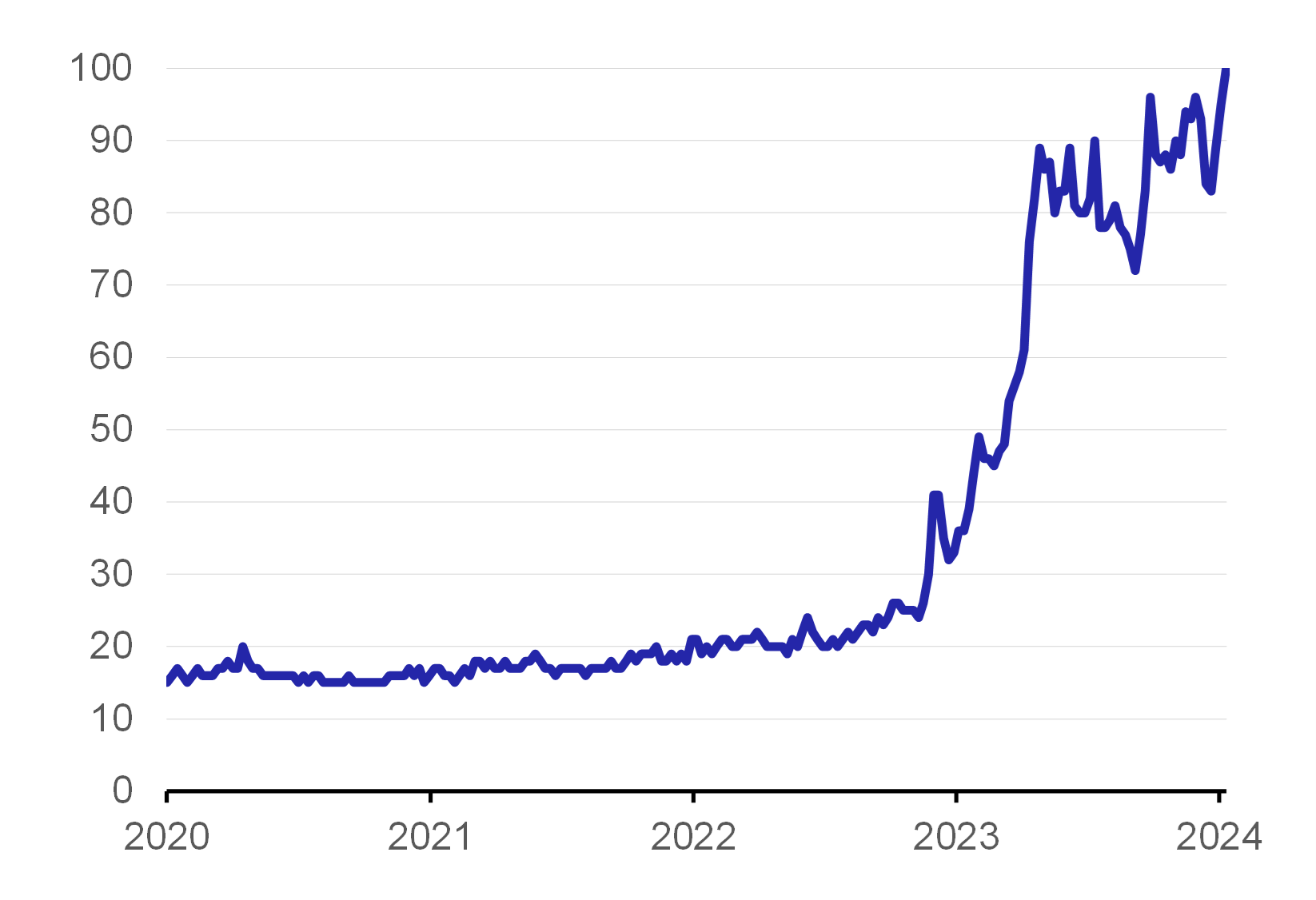
Source: Google Trends
Note: The numbers represent relative interest in searches, with a value of 100 representing the highest possible popularity of the term.
As AI has the potential to significantly impact society, it is important how the public perceives its arrival and usefulness. For example, an Ipsos survey at the end of 2021 showed that the attitude of around 20,000 adults to AI varies across 28 countries. Adding the GDP per capita indicator showed that people from richer economies are more reticent about AI products and services, whereas those from developing and emerging economies are more willing to accept AI (Chart 2). Looking, for example, at OECD data on the number of AI-related patents, the world leaders are the USA, Asia (especially Japan, South Korea and China), while the EU is not lagging behind either.
Chart 2 – Public sentiment towards artificial intelligence
(%; rhs in thousands of USD)
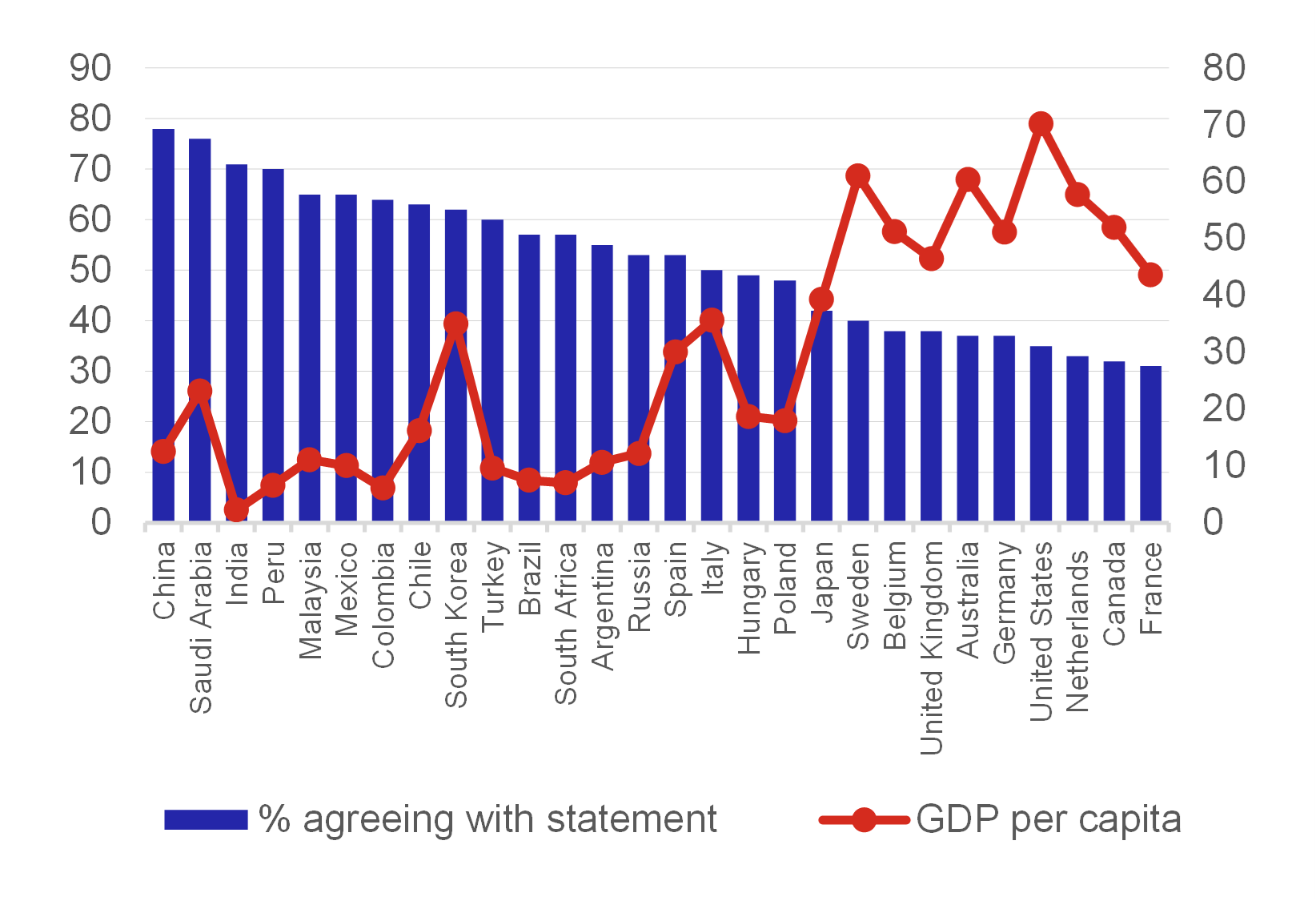
Source: Ipsos, World Bank
Note: Survey at the end of 2021. A statement that AI-powered products and services have more advantages than disadvantages.
Investing in and implementing artificial intelligence
Artificial intelligence is penetrating more and more areas, and its use is crucial for future economic activity. A 2018 study by the McKinsey Global Institute predicted that roughly 70% of businesses could adopt at least one type of AI technology by 2030, with less than half are likely to use the full range of AI technologies. The deployment of AI tools is currently rapidly increasing and we are finding them in a wide range of areas. In the EU, for example, despite the high heterogeneity between the individual members, 8% of companies with at least ten employees used it last year. For the euro area, the figure is even just under 9%, with Chart 3 showing that Denmark (15.2%) reported the highest share of businesses using AI in 2023, followed closely by Finland (15.1%). A widespread use of AI is also evident in Luxembourg (14.4%), Belgium (13.8%), the Netherlands (13.4%) and Malta (13.2%). On the other hand, in most other countries, less than a tenth of enterprises used AI, with the lowest shares in Romania (1.5%), Bulgaria (3.6%), Poland (3.7%) and Hungary (3.7%).
Chart 3 – Deployment of artificial intelligence in the EU
(share of AI-using enterprises in 2023)
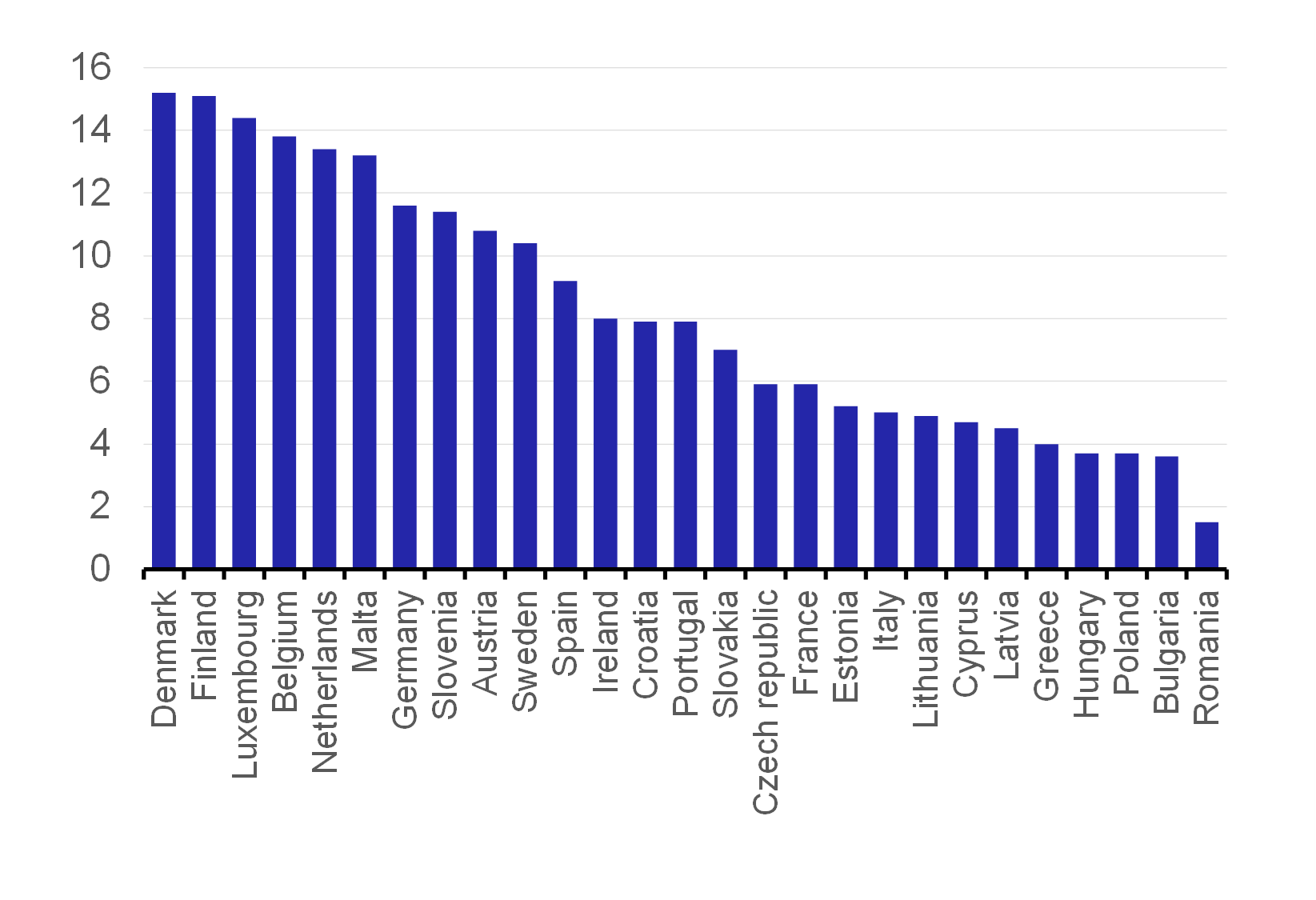
Source: Eurostat
Note: Enterprises with at least 10 employees, excluding the financial sector.
Less than a year after the introduction of a number of AI tools, surveys also confirm their regular use by enterprises. One example is a 2023 survey by McKinsey & Company, indicating that one third of respondents answered that they regularly use at least one generative AI application. Roughly 40% of respondents also said they plan to increase investment in AI due to the overall progress in this area. Looking at the published value of incoming investment in AI using the example of the EU, the figures have been rising in recent years (Chart 4). The most significant investment inflows were seen mainly in Germany, Sweden, France, the Netherlands and Spain last year. However, these five EU member states have long had above-average levels compared to the rest. In 2023, for example, Malta, Latvia, Cyprus, Croatia and Bulgaria recorded more or less zero incoming investment. However, these states have not been attracting AI investors over the long term.
Chart 4 – EU countries attracting most investment in AI
(reported incoming investments in USD millions)
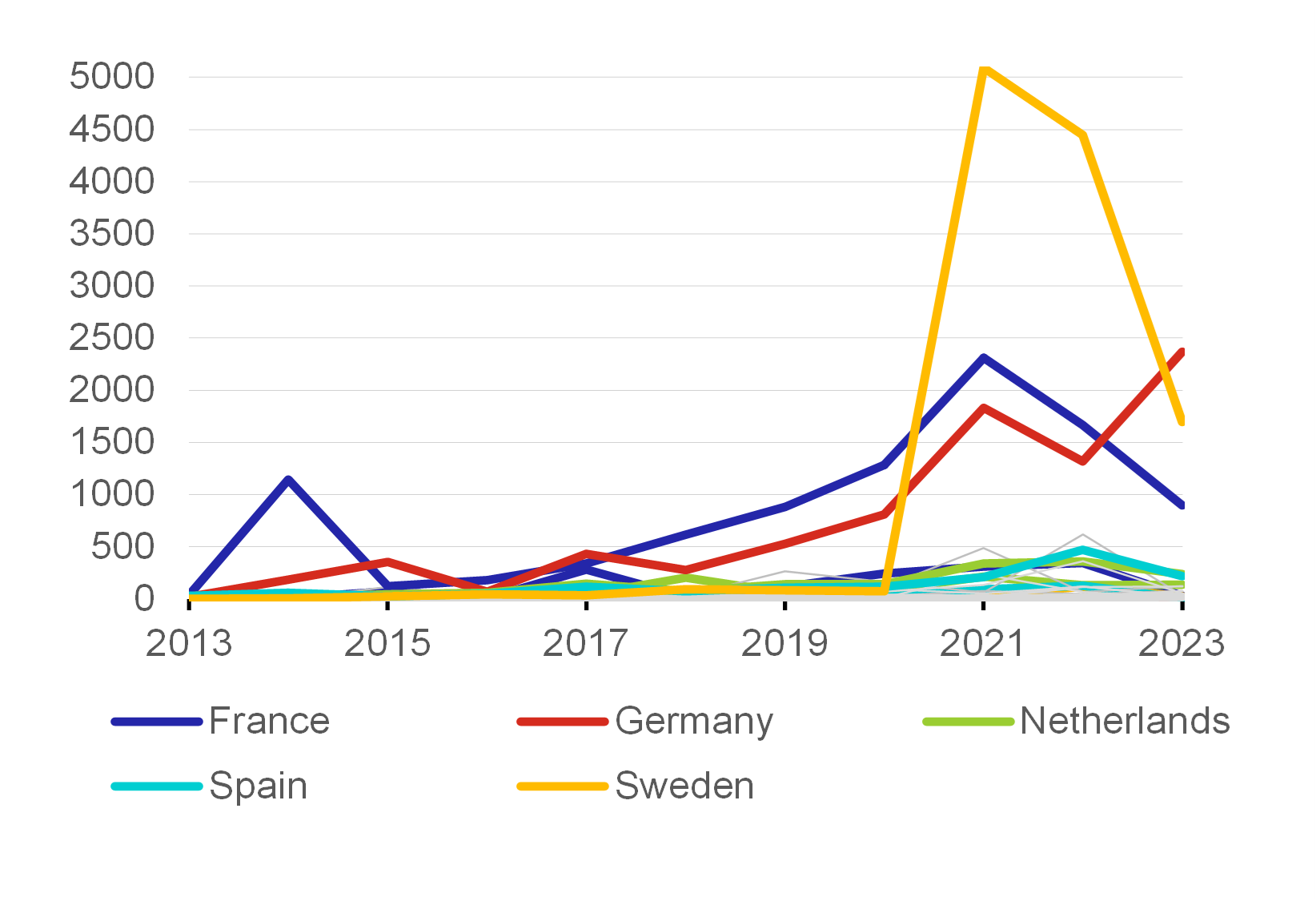
Source: ETO Country Activity Tracker
Specific examples
Although the AI boom is still in its early stages, its use is already quite widespread. The previously mentioned survey showed that publicly available AI tools are implemented across regions (Chart 5) and sectors (Chart 6) and also in various “forms”. Specifically, almost 80% of all respondents have encountered AI in some form (at or outside work), and over 20% regularly use it at work. In terms of region, regular AI use is highest in North America, while in terms of industry, technology, media and communications lead. The most commonly cited more specific uses of generative AI tools are in marketing and sales, product and service development, and service operations, with disruptive changes expected in the technology and financial services industries.
Chart 5 – Exposure to generative AI tools by region
(% of respondents)
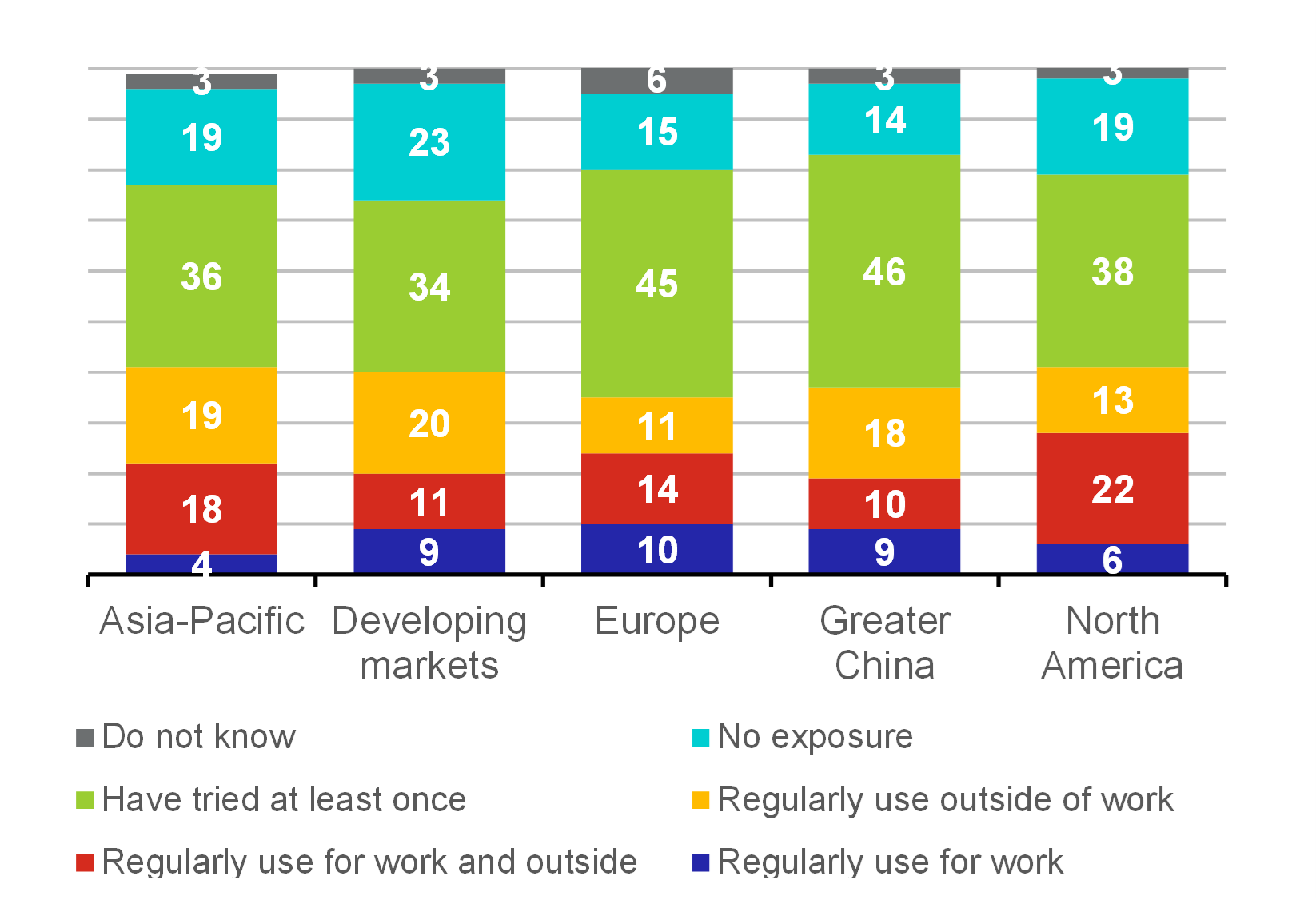
Source: McKinsey & Company
Note: Due to rounding, the figures may not add up to 100%.
Chart 6 – Exposure to generative AI tools by industry
(% of respondents)
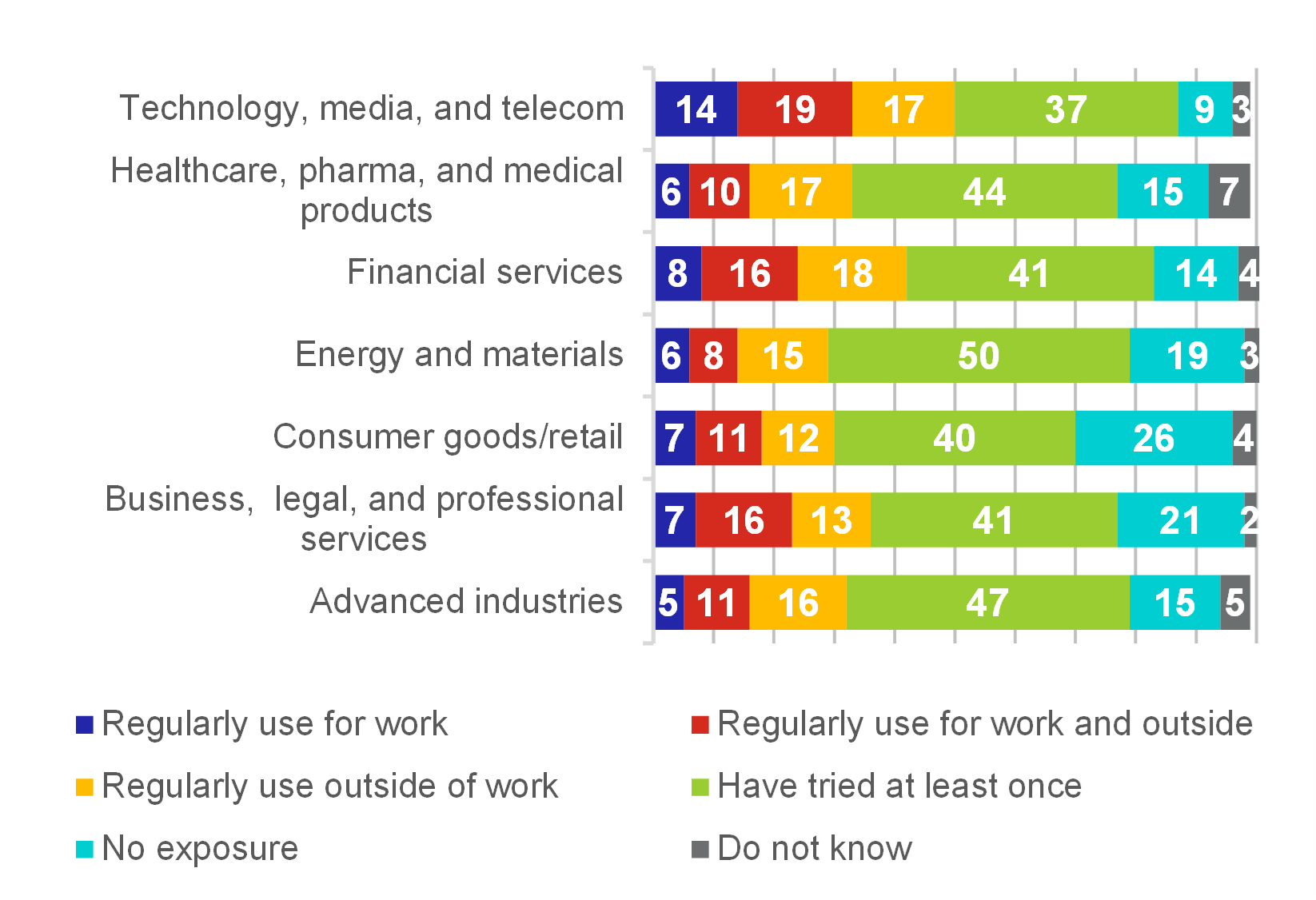
Source: McKinsey & Company
Note: Due to rounding, the figures may not add up to 100 %.
Concrete examples of the useful application of AI can be found across sectors. For example, in healthcare, AI has high potential through diagnostic support based on patient data or the actual evaluation of examinations. In the automotive industry, the application of autonomy, whether in car maintenance or driving itself. In transportation and logistics in general, AI can effectively manage traffic to reduce congestion in the form of traffic jams while increasing safety. AI could help financial services through personalisation, greater automation of operations, and more efficient investing or personal finance management. Retail can also harness AI’s potential through personalisation, design and manufacturing, as well as through anticipating customer demand. Media archiving, tailor-made content creation and personalised marketing and advertising will also play a role in technology, media and communication. In manufacturing, AI can potentially improve monitoring and automatic correction, and optimise supply-chain fluidity. However, AI also has potential in the energy sector, whether in the form of smart meters or more efficient grid operation and maintenance. Another topic is the impact of AI on education, where systemic changes will probably have to occur, for example in assessment. The classic writing of theses at universities is also likely to undergo changes. There will be truly revolutionary shifts in some fields. For example, the one taking place in the film industry is shocking, and it is already technically possible to make a film with a deceased actor. It will therefore be necessary to learn how to work with AI sensibly and effectively in general. (PwC, 2017)
The impact of artificial intelligence on productivity and, by extension, economic growth
AI has great potential to reverse the decline in productivity growth and thus contribute to growth in global economic activity. Economic growth has stagnated or slowed in many major economies since the 1980s. Chart 7 illustrates this development using the example of the seven most developed countries in the world (the G7), where growth has fallen on average from 3% to about a weak half over the past few decades. According to an earlier study, “Sizing the prize” by PwC from 2017, AI could potentially contribute USD 15.7 billion to the global economy by 2030, corresponding to a 14% increase in global GDP. The greatest economic benefits from AI are likely to be felt in China (26% increase in GDP), but also in the US (14.5% increase), these two making up about 70% of the global economic impact. More than half of the economic benefits will be driven by increased productivity. However, AI-driven product improvements supporting consumer demand will also play a major role. As AI increases productivity, product value, and consumption in general, retail, financial services and healthcare will see the highest profits, according to the study. Yet the pace of AI adoption, as well as the global interconnectedness and the structure of the labour market in a given country, will affect the size of the impact.
Chart 7 – Real GDP growth in recent decades
(annual GDP growth rates in the G7 group of economies)
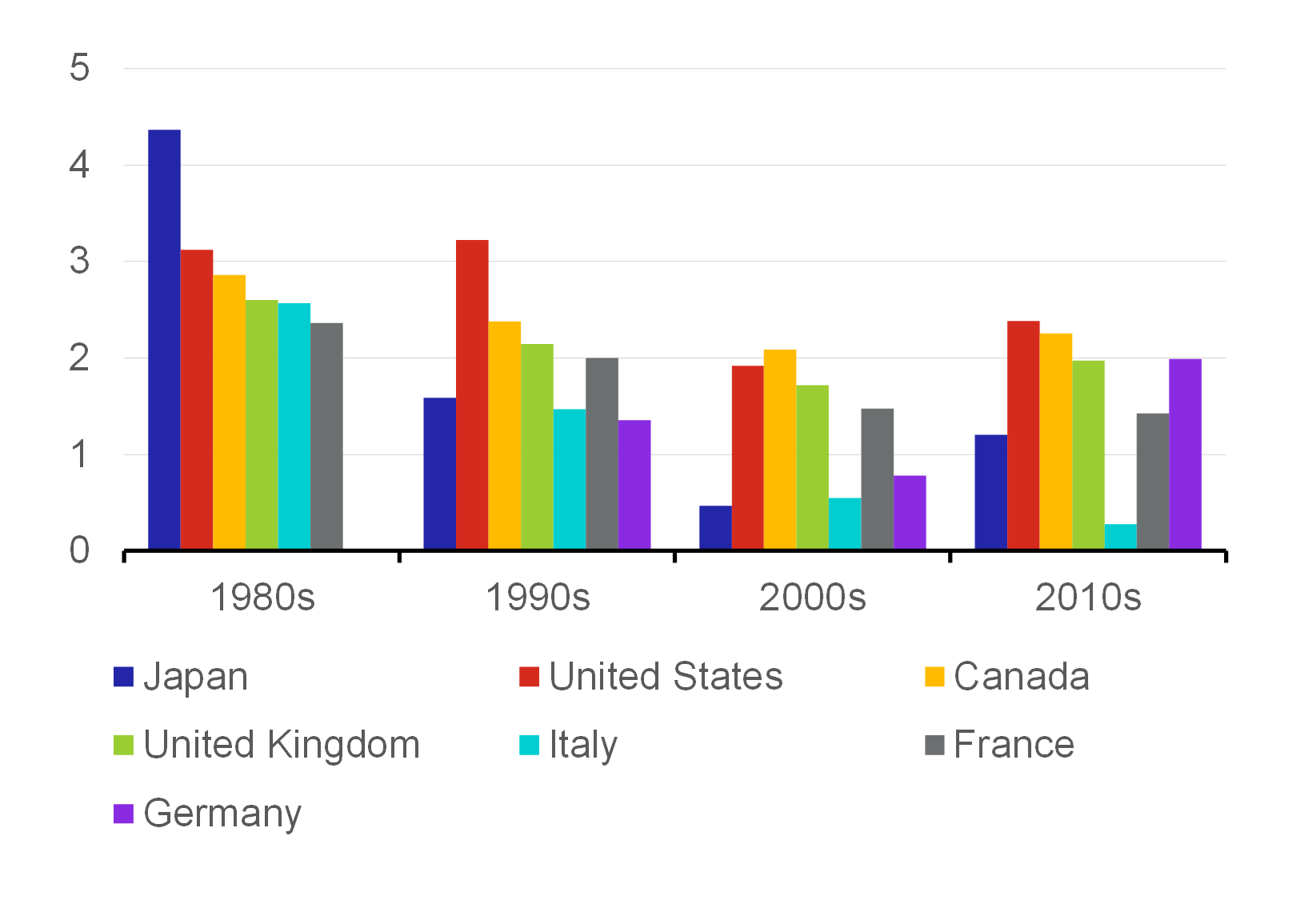
Source: OECD
Note: This is the average of the values for a given decade. Data are only available for Germany since 1992.
New studies on the economic potential of AI point to a promising to overwhelming impact, mainly thanks to productivity gains. One example is a 2023 study by McKinsey & Company that estimated the contribution of generative AI through productivity to the global economy at up to USD 4 trillion per year. Just how massive the impact could be is highlighted by the fact that this is roughly comparable to the United Kingdom’s GDP. About three quarters of the potential added value comes from four areas: customer operations, marketing and sales, software engineering, and research and development. Generally speaking, all industries will feel the impact, but banking and retail, for example, could see an especially strong impact on revenues. The full use of AI could mean an additional USD 300 billion per year and up to USD 600 billion per year for retail. In general, therefore, AI can create both new products and services as well as entire industries, which would increase consumer demand and create new sources of income.
Potential problems and challenges associated with AI deployment
Reality or “fake news”? Voice, image and video generation will be a potentially big problem for the credibility of information sources. This might seem quite harmless, yet even now, according to various surveys, people are incorrectly attributing authorship, i.e. whether it is really reality or an image created by AI. Images generated with Midjourney (especially the new version 5)[5] are captivating and flooding the world. Fake yet very realistically executed photos of Pope Francis in a luxurious white winter jacket and images of ex-US President Donald Trump being arrested are well known. And what if they were also fake, yet hardly differentiable from reality, videos with audio? The potential for abuse is therefore huge, especially for the dissemination of false or alarmist news, but also in the “unfair” influencing of public opinion. This will be an enormous challenge for our society, in which social media is at the forefront. Yet it may also be an opportunity for reputable media such as TV news, established dailies and magazines. These may be more sought-after as the threat from fake news increases, as the reader will not have a quick opportunity to verify whether the information received is reality, fiction or fraud.
The adoption of AI can be very energy-intensive and environmentally demanding. The massive adoption of AI may be slowed due to the energy consumption of some applications, e.g. image generation, which usually do not bring any “pure” added value. Devices that support AI are generally many times more energy-hungry than traditional information sets, and their cooling may require much more water. Yale University professor K. Crawford (2022), for example, states in her book that one GPT chatbot query can consume up to a thousand times more energy than a Google search query. She also states that a normal conversation with ChatGPT (20 to 50 questions) requires about half a litre of fresh water to cool servers in data centres. A study by Li et al. (2023) says, for example, that just the training of the GPT language model on GPT-3 consumed 700,000 litres of water. This is same quantity that would be sufficient for the average person in a Czech household for more than 20 years.
Although AI raises a lot of expectations and prospects for benefits, caution is important. There will certainly be barriers and costs in the transition to AI, and the adoption of AI could potentially exacerbate disparities between states, but also between companies and workers, as the benefits are likely to be uneven. Despite the previously mentioned position, the leaders in AI promotion are mostly developed states, which could thus increase their lead over developing states. They are being more or less forced to do so due to the slowing GDP growth, but there is also an incentive to replace humans with machines, as wages in these states tend to be high. China is an exception in this regard, investing massively in AI and implementing a national strategy to become a global supply-chain powerhouse (McKinsey Global Institute, 2018). A new IMF analysis (2024) from January this year even warns of worsening inequality and greater social tensions, as developing states will not be able to fully exploit the benefits of AI. From the workers’ point of view, those with lower incomes and of higher age may be at a disadvantage compared to high-income and young employees, who are likely to become better off. How the impact of these processes on the convergence of emerging and developing states will manifest itself remains a question.
Ethical issues, for example, are an important topic related in AI use. As AI technology is somehow developed and trained, efforts must be taken to keep it neutral, in other words, impartial. Training it in a responsible manner is therefore essential for its subsequent functioning. Given the significant quantities of data fed into AI platforms, the safe use of these data must also be ensured, as they will be used to improve and further train AI. Users should be cautious and should not enter data that they do not want to publish, or that are secret or sensitive in any way.
The challenge of regulating the adoption and use of AI must also not be neglected. There is a general effort to properly configure AI, yet the lack of precedent means the regulatory environment regarding AI is undeveloped, and there are no binding global standards. However, the first step towards defining boundaries has been taken by the European Union through new legislation in the form of the Artificial Intelligence Act. Negotiations on this regulation culminated at the end of last year, while the Act is not expected to enter into force until 2025 at the earliest. The aim of the regulation is to ensure the safety of AI systems deployed in the EU (especially high-risk ones such as for critical infrastructure or the judiciary) while respecting the EU’s fundamental rights and values. The Act should also support investment and innovation in AI in Europe.
However, many companies are not yet addressing the potential challenges associated with greater AI adoption. In fact, the recent McKinsey & Company survey already mentioned several times revealed that only about 20% of respondents (employers) regulate AI use by employees in some way. The three most relevant risks when implementing generative AI they stated were: inaccuracy, cybersecurity, and intellectual property infringement (Chart 8). However, the survey also showed that few companies are actually trying to mitigate the most frequently cited risk: inaccuracy. Yet the numbers of incidents and controversies surrounding AI are growing every year, as awareness of the misuse of this technology is also growing (Chart 9), and the topic should therefore not be overlooked in the future.
Chart 8 – Risks related to artificial intelligence
(% of respondents)
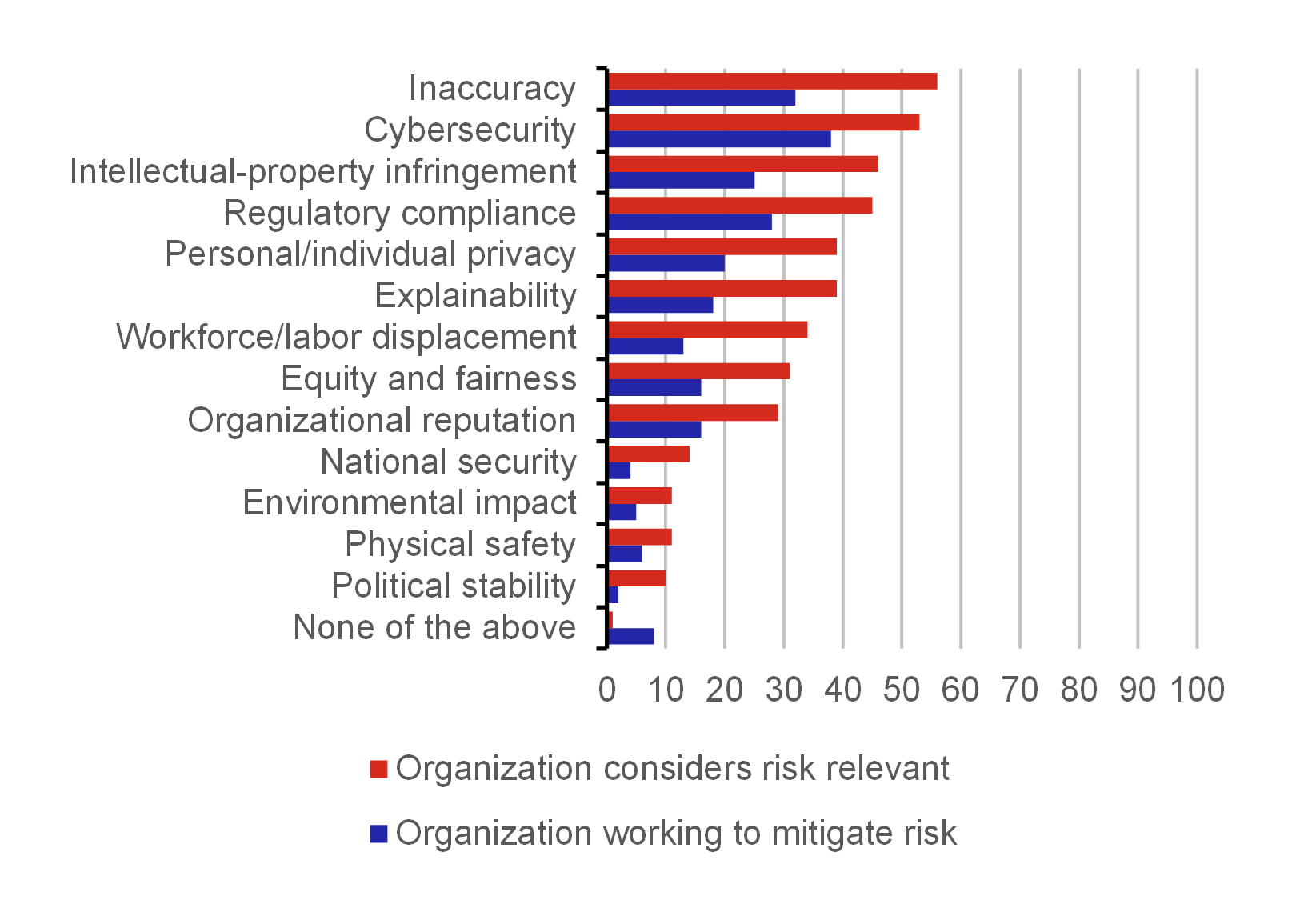
Source: McKinsey & Company
Note: Risks that organisations consider relevant and seek to mitigate.
Chart 9 – Incidents and controversies in artificial intelligence
(number of AI-related incidents and controversies)
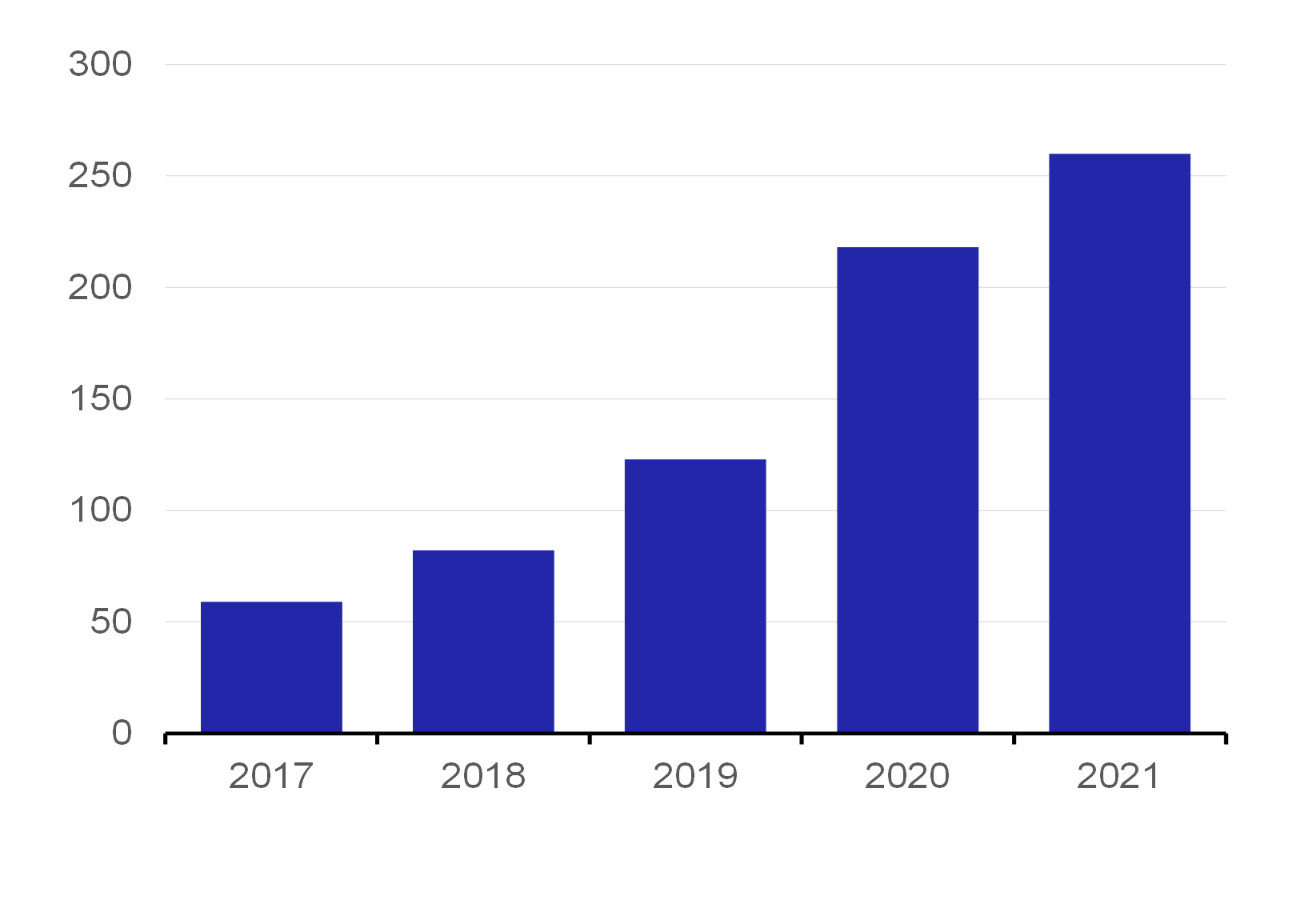
Source: AIAAIC Repository
Artificial intelligence and the labour market
The labour market and the ability of AI to “replace” employees is one of the concerns for the future. It can reasonably be assumed that many jobs will be threatened or replaced, especially those with a large proportion of activities that are routine or can be automated. In many cases, however, AI is rather more likely to complement human work and improve performance. There will be dynamic changes on the labour market (e.g. greater employee turnover), but it will be important for companies to invest in improving employee qualifications or giving them the necessary retraining. Moreover, the demand for AI tools will grow in many industries, and therefore more experts will be needed not only to develop them, but also to maintain them, creating new jobs.
Generative AI has the potential to significantly change the work environment and the nature of work. The automation of work activities that take up to 70% of employees’ time will be crucial. According to recent estimates, AI should be able to automate up to half of work activities between 2030 and 2060. Such advances mean that labour productivity could grow across the economy. Labour productivity could grow by 0.1% to 0.6% per year to 2040, depending on the scale and scope of AI adoption. However, it will also be important to invest in workers and support them when learning new skills or completely changing careers. If these risks are reduced to a minimum, AI could make a significant contribution to global economic growth. (McKinsey & Company, 2023a)
However, expert opinion on the specific impact of AI on the global labour market is not unanimous. The only consensus is that there will be significant labour movements. In the short to medium term, there are likely to be structural job shifts but also reductions in the numbers of workers in areas where the human factor is no longer needed, while job creation is more likely to prevail in the long term (European Parliament, 2019). As AI will affect labour productivity, it may also have an impact on the demand for labour and therefore wages. A recent analysis by the IMF indicated that AI will affect about 40% of all jobs worldwide, while in advanced economies it may be as high as 60% (greater risks but also opportunities), while in low-income countries only about 26%, with emerging markets also recording a smaller share (Chart 10). On the other hand, large-scale retraining and job creation should take place thanks to the AI value chain itself and also thanks to changes in productivity and consumer demand (McKinsey & Company, 2023b). Not only will new “creatives” be needed to further develop AI, but also a group to maintain, operate, and regulate the technology. In general, a careful balance of policies will be needed to properly harness the potential of AI. States will need to create environments and retraining programmes for vulnerable workers to make the transition to AI more inclusive and limit any worsening of overall inequality (IMF, 2024). Moreover, AI cannot, at least for now, replace all human skills.
Chart 10 – The impact of artificial intelligence on jobs
(employment shares by exposure to AI and complementarity)
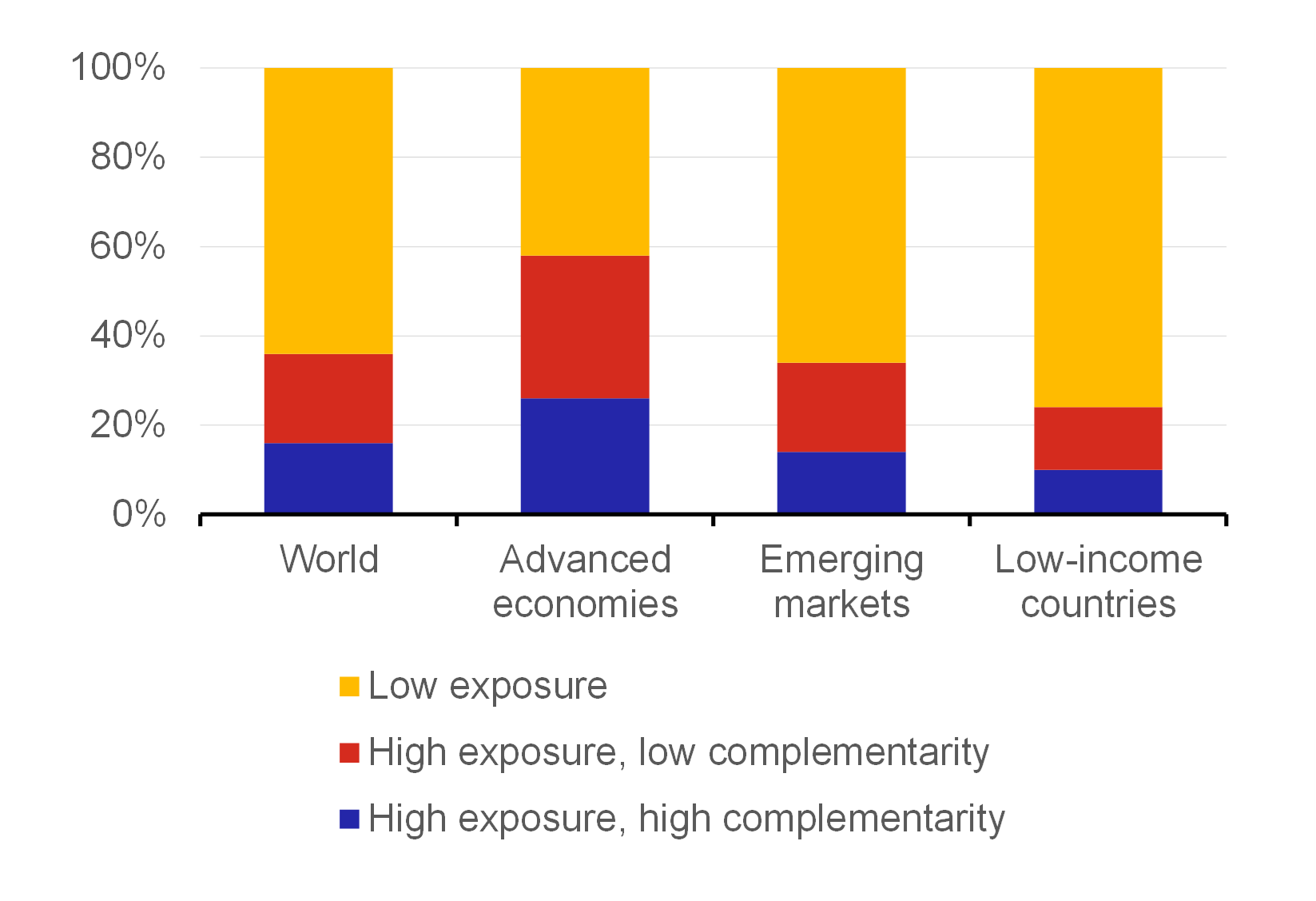
Source: ILO, IMF
Note: The share of employment within each group of states is calculated as a weighted average of the working-age population.
Conclusion
Artificial intelligence is making its way into virtually all areas of our lives, thus starting a new era. The advent of this technology has attracted worldwide attention and generated huge enthusiasm, as the first pilot projects (such as ChatGPT and Bard) are so far convincing. On the other hand, there is also a certain amount of concern and timidity. While AI could potentially boost global economic growth by boosting labour productivity, it could also replace many jobs, exacerbate inequality, and raise ethical issues. If we were asked to state our own position on whether humanity has a revolutionary yet double-edged weapon in its hands, we are inclined to think that it does. So, there will be specific areas where AI will need to be supervised. On the other hand, in a number of areas, AI will bring revolutionary changes that simply belong to the 21st century. The introduction of AI seems rather similar to the early days of the internet. As we all know, today we basically could not imagine life without it.
However, time is needed to fully appreciate the benefits and risks. The net effect of AI’s potential impact on the global economy is difficult to predict. We can see that a set of regulatory and other policies will need to be presented to harness the enormous potential of AI for the benefit of all and to face up to the significant challenges (ethical, privacy, legal, criminal, etc.). The further development of AI will also depend on whether its use will be charged (lower versions of the software) or not.[6] We will continue to focus on AI from the perspective of economists in future issues of GEO.
Sources
Adobe Firefly (2024): Generativní umělá inteligence vs. Jiné typy umělé inteligence, 2024, https://www.adobe.com/cz/products/firefly/discover/generative-ai-vs-other-ai.html
Atashbar, T. – Shi, R. A. (2023): AI and Macroeconomic Modeling: Deep Reinforcement Learning in an RBC model in: IMF Working Papers, Volume 2023, Issue 040. https://www.elibrary.imf.org/view/journals/001/2023/040/article-A001-en.xml
Crawford, K. (2022): The atlas of AI. Power, Politics, and the Planetary Costs of Artificial Intelligence, Yale University Press, 2022. ISBN: 0300264631
Dřímalka, F. (2023). Budoucnost nepráce. [The no-work future] 1st issue, ISBN 978-80-11-03771-0
Li, P., Yang, J., Islam, M. A., & Ren, S. (2023): Making AI Less “Thirsty”: Uncovering and Addressing the Secret Water Footprint of AI Models, Cornell University
European Parliament (2019): Economic impacts of artificial intelligence (AI), July, 2019, https://www.europarl.europa.eu/RegData/etudes/BRIE/2019/637967/EPRS_BRI(2019)637967_EN.pdf
McKinsey & Company (2023a): The economic potential of generative AI: The next productivity frontier, June, 2023, https://www.mckinsey.com/capabilities/mckinsey-digital/our-insights/the-economic-potential-of-generative-ai-the-next-productivity-frontier#introduction
McKinsey & Company (2023b): The state of AI in 2023: Generative AI’s breakout year, August, 2023, https://www.mckinsey.com/capabilities/quantumblack/our-insights/the-state-of-ai-in-2023-generative-ais-breakout-year
McKinsey Global Institute (2018): Modeling the impact of AI on the world economy, September, 2018, https://www.mckinsey.com/featured-insights/artificial-intelligence/notes-from-the-ai-frontier-modeling-the-impact-of-ai-on-the-world-economy
MMF (2023): Artificial Intelligence. What AI means for economics, December, 2023, https://www.imf.org/en/Publications/fandd/issues#1e7ad5c45f7145edac4368379d57f7ab
MMF (2024): Gen-AI: Artificial Intelligence and the Future of Work, January, 2024, https://www.imf.org/en/Publications/Staff-Discussion-Notes/Issues/2024/01/14/Gen-AI-Artificial-Intelligence-and-the-Future-of-Work-542379
PwC (2017): Sizing the prize, June, 2017, https://www.pwc.com/gx/en/issues/analytics/assets/pwc-ai-analysis-sizing-the-prize-report.pdf
Keywords: artificial intelligence, productivity, economic growth, labour market
JEL classification: E24, O33, O40
[1] The lead paragraph was generated with the help of AI (ChatGPT) on the basis of this article
[2] Intelligence (from the Latin words ‘inter’ and ‘legere’) denotes a disposition for thinking, learning and adaptation, and manifests itself in intellectual performance. There are several types of classifications of intelligence. Robert Sternberg, author of the Triangular Theory, distinguishes between analytical, creative and practical intelligence. Howard Gardner takes a different angle, defining linguistic, logical-mathematical, spatial, musical, bodily-kinesthetic, intrapersonal, naturalist and existential intelligence. David Perkins then defines neural, experiential and reflective intelligence. A detailed understanding of the nuances of the given classifications goes beyond the scope of this text, but it illustrates what can be understood by the term ‘intelligence’ and where artificial intelligence subsequently has a place.
[3] See e.g. Dřímalka (2023).
[4] In the authors’ opinion, it is not a question of whether, but how long it will be before AI begins to have a say in the preparation of macroeconomic forecasts, where dynamic stochastic equilibrium models (DSGEs) currently play a leading role. Indeed, AI could help with many problems in this area, from the linearity of the links in these models to their costly recalibrations. One of the first papers to address the application of AI in macroeconomic models was that by IMF economists, see Atashbar and Shi (2023).
[5] It is clear that new versions – and not only of Midjourney – will arrive and will be increasingly perfect. Some other competing products, such as ControlNet, DALL-E and Dream Studio, have some other improvements for image creation.
[6] If lower versions are always made available to the general public free of charge, the massive use of AI would be greatly stimulated.